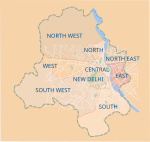Nangal Dewat
Cities and towns in South West Delhi districtDelhi geography stubsUse Indian English from December 2018
Nangal Dewat is a census town in the South West district of the Indian state of Delhi. Airport Authority of India (AAI) acquired the village in 1965 for future expansion, however, due to repeated protests, it was not fully acquired until 2007. The settlement is made up of four blocks and has many parks and lands for future use. This is the first modern village in Delhi with broad roads and multi-story homes. Rental properties are a source of income for the villagers.
Excerpt from the Wikipedia article Nangal Dewat (License: CC BY-SA 3.0, Authors).Nangal Dewat
New Delhi
Geographical coordinates (GPS) Address Nearby Places Show on map
Geographical coordinates (GPS)
| Latitude | Longitude |
|---|---|
| N 28.525963 ° | E 77.13891 ° |
Address
110037 New Delhi (Vasant Vihar Tehsil)
Delhi, India
Open on Google Maps



